Typically, a crow refers to several species in the genus Corvus that share common characteristics like glossy black plumage, omnivorous diets, and high intelligence. While it sports a different name, a raven is really a large crow and is used to describe various species within the Corvus genus. Other species in the Corvus genus include rooks and jackdaws, which are not covered in this list. Additionally, there are many bird species that are colloquially known as crows but aren’t part of the Corvus genus. After pouring through the more than 40 official crow species, we’ve found the top ten largest crows still alive on earth.
10. Long-billed Crow (Corvus macrorhynchos)
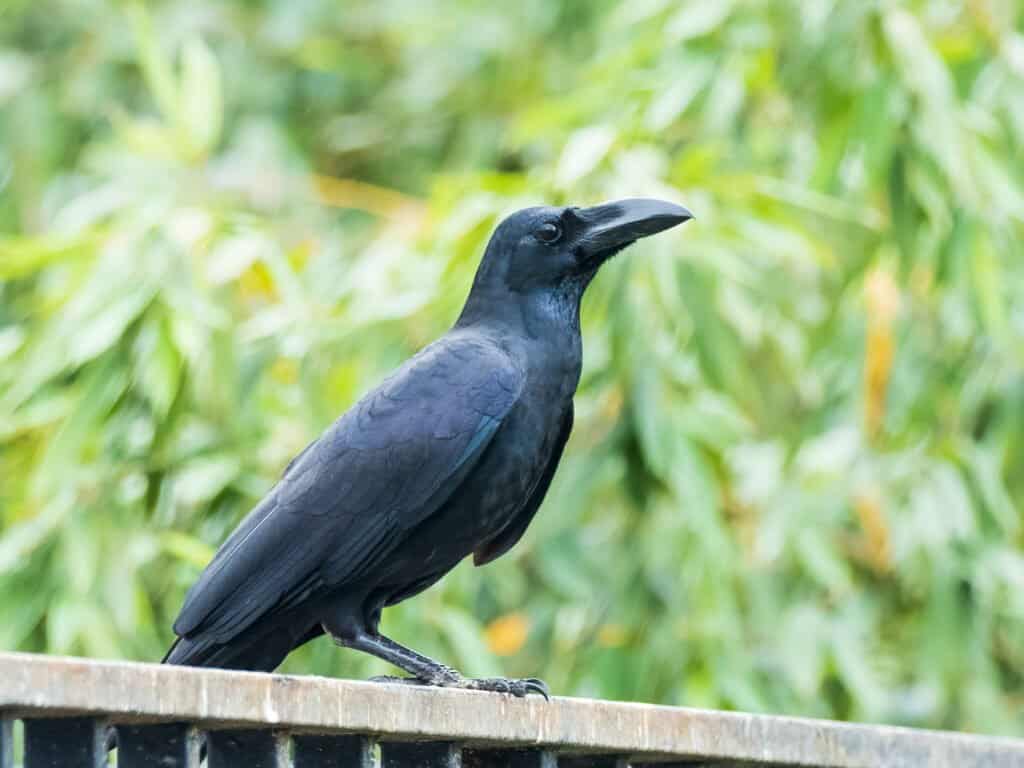
©Wright Out There/Shutterstock.com
- 45 to 53 cm or up to ~21 inches long
This crow is endemic to the Maluku Islands, which belong to Indonesia. The long-billed crow has a large bill and striking white irises, along with the standard glossy black plumage common in most crow species. While an adaptable and resourceful bird, the overall population has declined enough recently to warrant a near-threatened status by the IUCN.
The long-billed crow prefers forested terrain, although it seems to do ok in partly logged areas and cultivated land. Like other crows, the long-billed has a distinct call, described as similar to the yapping of a puppy. Since it is restricted to its archipelago, the continued success of the species revolves around habitat preservation and is far from certain.
9. Torresian Crow (Corvus orru)
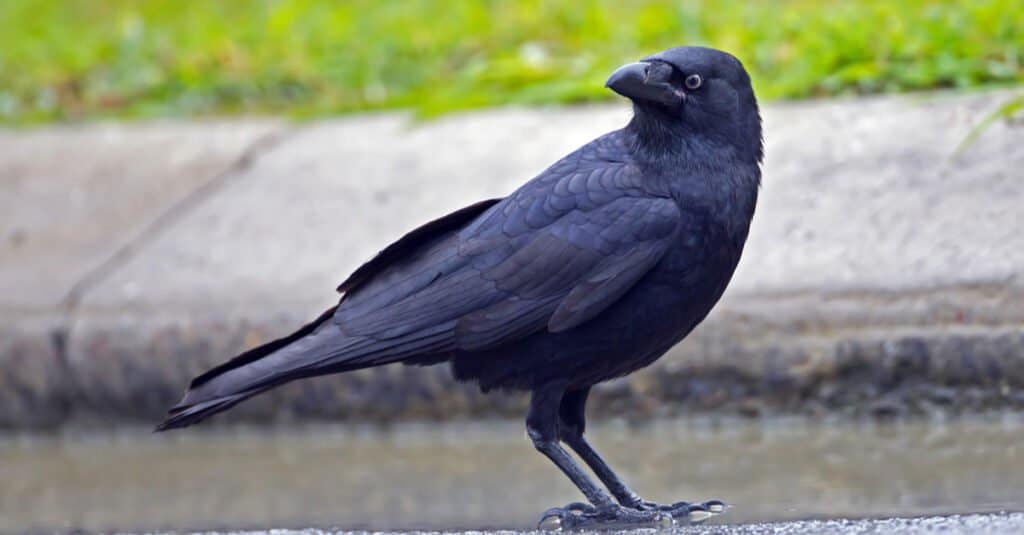
Torresian Crow are commonly found in Australia
©Wright Out There/Shutterstock.com
- 48 to 53 cm or up to ~21 inches long
Close in size to the long-billed, the Torresian crow’s average size (48-53 cm) has a larger minimum than the long-billed (45-53 cm). It is also commonly referred to as the Australian crow or Papuan crow and is native to areas of north and west Australia, Papua New Guinea, and Indonesia. The Torresian also has white eyes with a thin blue eye-ring but can be differentiated from the long-billed due to the presence of feathers with a white base on the neck and head. It is one of six crow species to inhabit Australia.
The Torresian crow is monogamous, and both parents share feeding duties. The Torresian also eats more grain than related species but is an opportunist and will eat garbage and carrion. Populations of the crow have been increasing in multiple places, and the species is listed as least concern by the IUCN.
8. Forest Raven (Corvus tasmanicus)
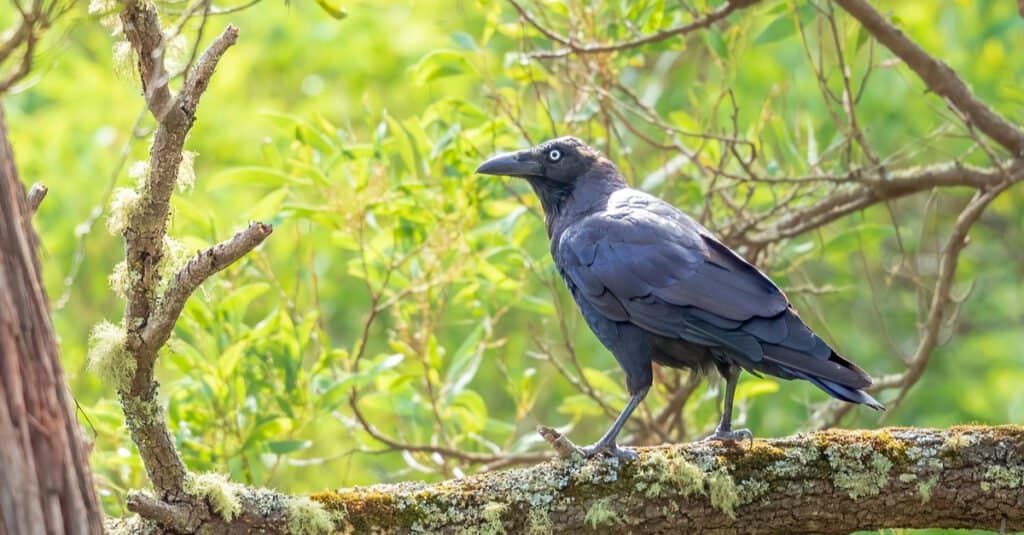
The forest raven is another Australian species
©Wright Out There/Shutterstock.com
- 50 to 53 cm or up to ~21 inches long
Also referred to as the Tasmanian raven, this large crow is native to the island of Tasmania and a few locations in southern Victoria, Australia. It is the largest Corvus member living in Australia and has a wingspan generally between 36-44 inches. Due to its environmental adaptability, the forest raven is listed as least concern by the IUCN.
While similar to most crow species with a glossy black plumage, the forest raven has comparably large wings, which, at rest, can almost reach back to its tail. The forest raven is omnivorous and commonly seen feeding on roadkill. Despite its proliferation, the forest raven has been seen as a threat to agriculture, and there are no hunting restrictions against them. Its call is deeper and more gravelly than many crow species, but it can also issue a loud bark as an alarm. On mainland Australia, its distribution is limited to forests, but it has been observed in multiple different environments in Tasmania, including alpine forests, terrain adjacent to open country, moors, eucalyptus forests, coastal scrub, and beaches.
7. White-necked Raven (Corvus albicollis)
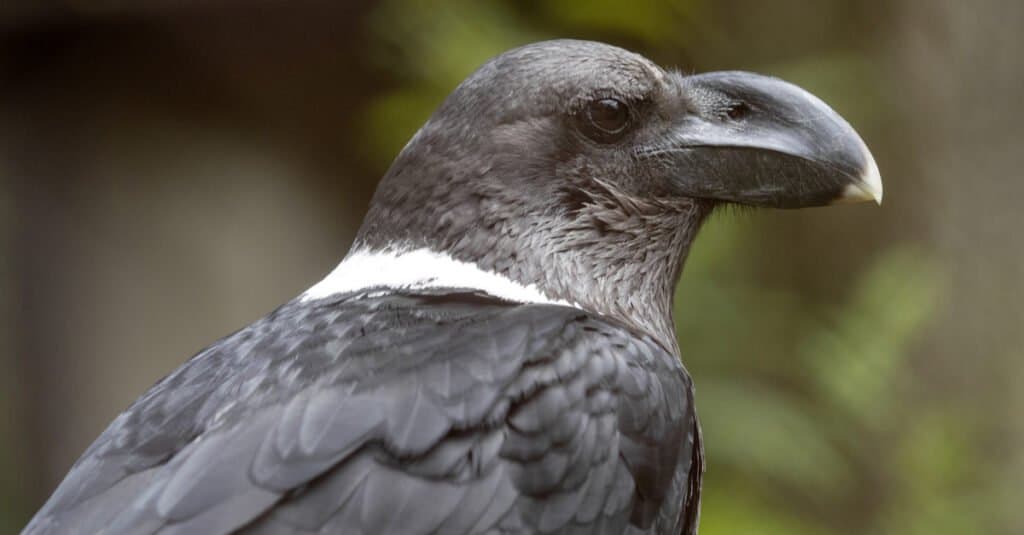
The white-necked raven can be found in
Africa
©Vladislav T. Jirousek/Shutterstock.com
- 50-54 cm or up to 21.25 inches long
The white-necked raven is a large bird native to eastern and southern Africa. It is more identifiable than other crow species because of its large, curved beak that ends in a white tip, along with a small patch of white feathers on the nape of its neck. The white-necked is predominantly black but appears to sport a purple sheen along its chest, throat, and neck.
Life expectancy for crows in the wild varies dramatically across species, but a healthy white-necked can live anywhere from 10-15 years. White-necked ravens in captivity can live to an astonishing 50 years of age. Like a lot of crows, the white-necked raven can practice mimicry, another display of the bird’s overall intelligence. The white-necked raven is listed as least concern by the IUCN.
6. Collared Crow (Corvus torquatus)
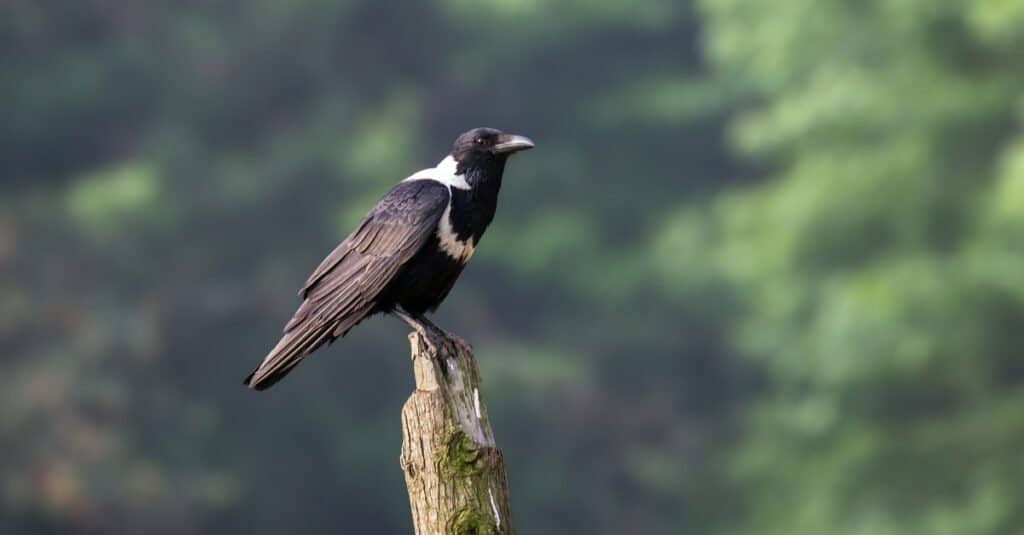
The collard crow is found in China and northern Vietnam
©Agami Photo Agency/Shutterstock.com
- 52-55 cm or up to ~21.7 inches
Not to be confused with the white-necked raven, the collared crow (also known as the white-collared crow and ring-necked crow) is native to China and northern Vietnam. The white collar of feathers around the neck is more prominent than the patch on the white-necked raven, and there are additional white patches on the upper back and chest.
The crow’s range is predominantly within the borders of China but not any further north than the area around Beijing. Despite its historical prevalence, the collared crow has been upgraded twice on the IUCN’s red list, culminating in a conservation status of vulnerable by 2018. Estimates place the total crow population somewhere between 2,500 and 9,900.
5. Brown-headed Crow (Corvus fuscicapillus)
- Up to 56 cm or 22 inches long
Like the long-billed, the brown-headed crow is endemic to Indonesia. It has a shiny black plumage (with a purple sheen) across most of its body, but the head and neck are usually dark brown. The beak is also notably large. These crows love to dine on fruits found in tree canopies.
The brown-headed crow loves living in virgin forests (i.e., has never been logged), secondary growth areas, and mangroves. While capable of living in open spaces, the brown-headed crow tends to avoid them. Like many species, the population is threatened by human activity, with habitat loss from logging, mining, and farming resulting in a moderate population decline. They are currently listed as near-threatened by the IUCN.
4. Brown-necked Raven (Corvus ruficollis)
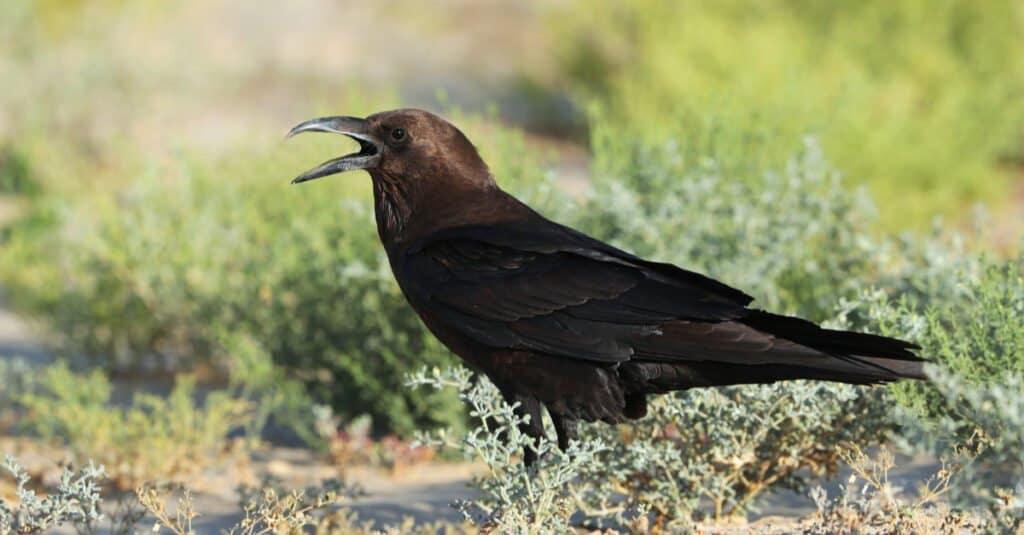
Brown-necked crows are mostly found
©Agami Photo Agency/Shutterstock.com
- 52-56 cm or up to 22 inches long
Similar to the brown-headed crow, this species sports the regular shiny black plumage with a brown neck and head. The feathers tend to turn browner as the bird prepares to molt. Currently, they are listed as least concern by the IUCN.
The range of the species is large, and it prefers desert environments with oases and palm groves. Brown-necked ravens have been found all over northern Africa, the Arabian Peninsula, and up into Iran. A study in Israel found that the crows often hunt together to catch certain animals, with one crow blocking exits while the other corners and kills its prey. Some preferred foods for the crow include lizards, snakes, locusts, grasshoppers, carrion, palm dates, and fruit.
3. Indian Jungle Crow (Corvus culminatus) and Large billed crow (Corvus macrorhynchos)

Indian jungle crows can grow to 23 inches in length!
©Marut Sayannikroth/Shutterstock.com
- Both species: 46-59 cm or up to 23.2 inches long
There’s a tie for our number three spot, with honors split between the Indian jungle crow and the large-billed crow. Jungle crows were all lumped together at one point but have since been split into three different species, the Indian jungle crow, the large-billed crow, and the eastern jungle crow. The differentiation between species is not immediately obvious and has to do with variations in vocal calls.
The Indian jungle crow is found across the Indian subcontinent beneath the Himalayan mountains and has a wide range of preferred foods. The range of the large-billed crow is even more extensive, with populations found in Southeast Asia, Afghanistan, Iran, Indonesia, Sri Lanka, and up and down the Asian pacific seaboard. Both crows do not experience predation from many animals but are susceptible to the H1N1 bird flu and various parasites. Their nests are also occasionally hijacked by the Asian koel. The koel will place its egg next to the crow’s eggs, hoping that the crow will take in the additional egg as one of its own. This type of brood parasitism means the Asian koel is free to spend more time foraging and breeding while the unsuspecting crow incubates and raises its young.
2. Common Raven (Corvus corax)

The common crow can weigh up to 4.4 pounds!
©Francisco Palomares/Shutterstock.com
- 54-67 cm or up to 26.3 inches long
This widely distributed bird is the second largest of all crows. The common raven is found across the northern hemisphere and may also be the heaviest of all crows, weighing up to about 4.4 lbs. The IUCN lists them as least concern.
Versatile and adaptable, the common raven leverages its omnivorous feeding preferences to find workable nutrition across a wide range of options. They have proliferated and existed alongside humans so long that in some areas, they are considered pests, while in others, they are venerated as god-like. Once they find a partner, the common raven mates for life. Currently, there are between 8 and 11 recognized subspecies, though the taxonomic breakdown will likely change as more research is conducted.
The common raven is one of the most intelligent crows on earth. They’ve been observed participating in play (exhibiting behavior that serves no biological necessity) by sliding down snowbanks for fun and have broken off twigs to play with socially, making them one of the only species in the animal kingdom to make their own toys. The common raven also loves getting others to do work for them; they’ve been known to call wolves and coyotes to the site of dead animals. The wolf or coyote will then open up the dead animal, creating more accessible scraps of food for the bird. Ravens and crows in Japan have also been observed placing nuts on roads. A car will run over the nut, cracking the shell. The raven then waltzes in and claims the food.
1. Thick-billed Raven (Corvus crassirostris)
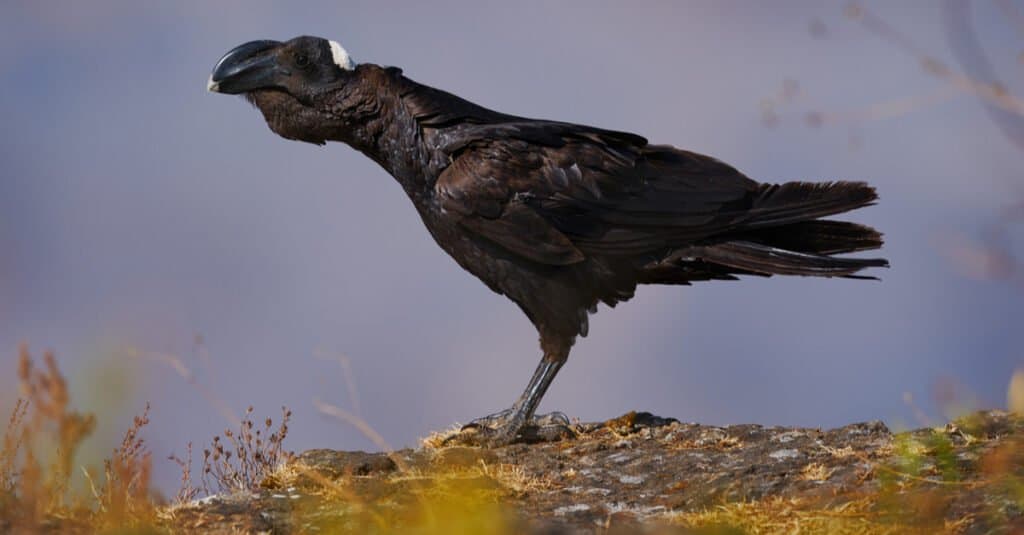
The thick-billed raven can grow up to 28 inches in length!
©Ondrej Prosicky/Shutterstock.com
- Up to 70 cm or 28 inches long
The largest species of crow in the world is the thick-billed raven. True to its name, the raven has a thick, compressed bill that is noticeably curved. In addition, deep nasal grooves give the raven a distinct appearance.
The thick-billed raven lives in the highlands of Eritrea, Somalia, and Ethiopia between roughly 5,000 ft and 11,150 ft. in elevation and can grow to more than two feet long. The bird is glossy black with brown on the throat and upper back. There is also a white patch on the nape of its neck, and the beak is white-tipped. The raven nests in trees and on cliffs, and like other species of crow, is omnivorous. The IUCN lists them as least concern.
Canuck the Crow
Crows have been featured on plenty of nature documentaries focusing on their adaptability and intelligence. Perhaps one of the more unique stories comes from Vancouver, Canada. A resident found and raised a crow, naming him Canuck and eventually releasing him into the wild with a red tag on his leg.
The crow has been seen all over the city causing mischief. It reportedly flew away with a knife from a crime scene, fought off a hawk with four of its buddies, and rode the Skytrain (above ground subway) through the city, walking on and off the train like a regular commuter. Occasionally it’s been reported that Canuck visits the gym, walks around the machines like a trainer, and then takes a nap. Unfortunately, he hasn’t been seen since 2019 and is most likely deceased, but not before becoming a celebrity with a Facebook fan page that once totaled over 100,000 members.
The photo featured at the top of this post is © Ondrej Prosicky/Shutterstock.com
Thank you for reading! Have some feedback for us? Contact the AZ Animals editorial team.






